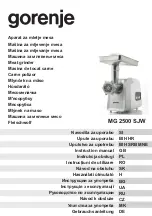
5
ENGLISH
for operations different from those intended could result
in a hazardous situation.
5. Service
a. Have your power tool serviced by a qualified repair
person using only identical replacement parts.
This
will ensure that the safety of the power tool is maintained.
Additional safety instructions for sanders
◆
Warning!
Contact with or inhalation of dusts arising from
sanding applications may endanger the health of the
operator and possible bystanders. Wear a dust mask
specifically designed for protection against dust and
fumes and ensure that persons within or entering the
work area are also protected.
◆
Thoroughly remove all dust after sanding.
◆
Take special care when sanding paint which is possibly
lead based or when sanding some woods and metal
which may produce toxic dust:
- Do not let children or pregnant women enter the work
area.
- Do not eat, drink or smoke in the work area.
- Dispose of dust particles and any other debris safely.
Electrical safety
This tool is double insulated; therefore no earth wire
is required. Always check that the power supply
corresponds to the voltage on the rating plate.
Additional safety instructions for Australia and
New Zealand
◆
This appliance is not intended for use by young or infirm
persons without supervision. Children must be supervised
to ensure they do not play with the appliance.
◆
If the supply cord is damaged, it must be replaced by the
manufacturer or an authorised Black & Decker Service
Centre in order to avoid a hazard.
Features
This tool includes some or all of the following features.
1. On/off switch
2. Lock-on button
3. Variable speed control knob
4. Dust extraction outlet
5. Sanding disc
Assembly
Warning!
Before assembly, make sure that the tool is
switched off and unplugged.
Fitting the sanding disc (fig. A)
◆
Place the tool on a table, with the spindle (6) facing up.
◆
Place the sanding disc (5) onto the spindle (6).
◆
Place the washer (7) onto the spindle (6) as shown. Make
sure the raised portion of the washer faces outwards.
◆
Fit the screw (8) onto the spindle (6).
◆
Hold the sanding disc steady and tighten the screw (8)
using the Allen key (9).
Fitting sanding sheets (fig. B)
Warning!
Never use the tool without a sanding sheet or
accessory in place.
◆
Press the sheet firmly and evenly onto the sanding disc (5),
making sure that the holes in the sheet line up with the
holes in the base.
Fitting and removing the dustbag (fig. C)
◆
Fit the dustbag (10) over the dust extraction outlet (4).
◆
To remove the dustbag, pull it off the dust extraction outlet.
Connecting a vacuum cleaner (fig. D)
◆
Insert the hose (11) of the vacuum cleaner into the dust
extraction outlet (4).
Use
Warning!
Let the tool work at its own pace. Do not overload.
Variable speed control
The variable speed control allows you to adapt the speed of
the tool to the workpiece material.
◆
Set the control knob (3) to the desired setting. Use a high
speed for wood, medium speed for veneer and synthetics
and low speed for acrylic glass, non-ferrous metals and
for removing paints.
Switching on and off
◆
To switch the tool on, press the on/off switch (1).
◆
For continuous operation, press the lock-on button (2)
and release the on/off switch.
◆
To switch the tool off, release the on/off switch.
To switch the tool off when in continuous operation,
press the on/off switch once more and release it.
Automatic brake system
This feature keeps the speed of the disc limited as long as the
tool does not touch the workpiece. As soon as the tool is placed
on the workpiece, the disc will reach its normal operating speed.
Emptying the dustbag
The dustbag should be emptied every 10 minutes.
◆
Shake the dustbag to empty the contents.
Summary of Contents for KA191E
Page 2: ...2 4 10 9 8 7 5 6 5 C A B ...
Page 3: ...3 4 11 D E ...
Page 51: ...51 ...
Page 52: ...52 ...
Page 53: ...53 ...






































